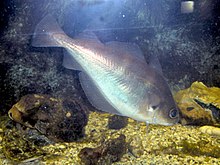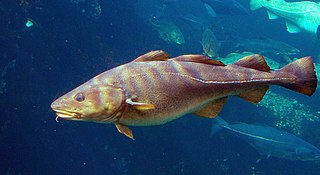
Cod is the common name for the demersal fish genus Gadus, belonging to the family Gadidae. Cod is also used as part of the common name for a number of other fish species, and one species that belongs to genus Gadus is commonly not called cod.

Pollock or pollack is the common name used for either of the two species of North Atlantic marine fish in the genus Pollachius. Pollachius pollachius is referred to as pollock in North America, Ireland and the United Kingdom, while Pollachius virens is usually known as saithe or coley in Great Britain and Ireland. Other names for P. pollachius include the Atlantic pollock, European pollock, lieu jaune, and lythe; while P. virens is also known as Boston blue, silver bill, or saithe.

The Gadidae are a family of marine fish, included in the order Gadiformes, known as the cods, codfishes, or true cods. It contains several commercially important fishes, including the cod, haddock, whiting, and pollock.

The haddock is a saltwater ray-finned fish from the family Gadidae, the true cods. It is the only species in the monotypic genus Melanogrammus. It is found in the North Atlantic Ocean and associated seas where it is an important species for fisheries, especially in northern Europe where it is marketed fresh, frozen and smoked; smoked varieties include the Finnan haddie and the Arbroath smokie.

Boreogadus saida, known as the polar cod or as the Arctic cod, is a fish of the cod family Gadidae, related to the true cod. Another fish species for which both the common names Arctic cod and polar cod are used is Arctogadus glacialis.

Gadus is a genus of demersal fish in the family Gadidae, commonly known as cod, although there are additional cod species in other genera. The best known member of the genus is the Atlantic cod.

Arctogadus glacialis, known also with ambiguous common names Arctic cod and polar cod, is an Arctic species of fish in the cod family Gadidae, related to the true cod. Arctogadus glacialis is found in icy water. They grow to about 30 cm long, and are favorite food of narwhals and other arctic whales.
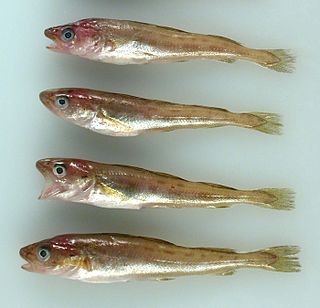
The saffron cod(Eleginus gracilis) is a commercially harvested fish closely related to true cods. It is dark grey-green to brown, with spots on its sides and pale towards the belly. It may grow to 55 cm and weigh up to 1.3 kg.

The poor cod is a temperate marine fish belonging to the cod family (Gadidae). It is red brown in colour and has a pronounced chin barbel. It may grow up to a length of 40 cm. It is usually found in small shoals at depths between 10 and 300 metres on muddy or sandy bottoms. Its distribution spans the eastern Atlantic, from Norwegian coasts to Portugal and along the Atlantic coast of Morocco. Spawning takes place towards the end of winter. They are often regarded as a mini species and are commonly confused with pouting as they have a similar appearance. They are often seen as a menace for anglers and have little commercial value and so are not currently at any risk of extinction.

The navaga is a relatively small species of fish in the cod family Gadidae. It inhabits the European arctic and subarctic waters of the Barents, White, and Kara Seas, from the Kola Bay to the Ob River estuary.
Zoarces is a genus of marine ray-finned fishes belonging to the family Zoarcidae, the eelpouts. It is the only genus in the subfamily Zoarcinae. These eelpouts are found in the northern Atlantic and northern Pacific Oceans.
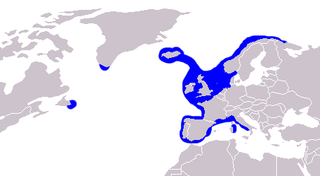
The common ling, also known as the white ling or simply the ling, is a large member of the family Lotidae, a group of cod-like fishes. It resembles the related rocklings, but it is much larger and has a single barbel. This species is unrelated to the pink ling, Genypterus blacodes, from the Southern Hemisphere. The common ling is found in the northern Atlantic, mainly off Europe, and into the Mediterranean Basin. It is an important quarry species for fisheries, especially in the northeastern Atlantic, although some doubts exist as to the sustainability of the fisheries. As an edible species, it is eaten fresh, frozen, or dried, but also preserved in lye, while the roe is a delicacy in Spain.

The southern blue whiting is a codfish of the genus Micromesistius, found in the southern oceans with temperatures between 3 and 7 °C, at depths of 50 to 900 m. Its length is commonly between 30 and 60 cm, with a maximum length of 90 cm. Maximum weight is at least 1350 g.

Trisopterus luscus is a seafish belonging to the cod family (Gadidae).

Pollachius pollachius is a species of marine fish in the Pollachius genus. FAO uses the English name pollack for this species. Together with Pollachius virens, it may also be referred to as pollock. Other names include European pollock, lieu jaune, lythe and in the Isle of Man, callig. It is common in the north-eastern parts of the Northern Atlantic, including the Bay of Biscay and North Sea. Adults can grow up to 130 cm (51 in) and weigh up to 12.41 kg (27.4 lb), although more commonly their maximum length is 75 cm (30 in).

Gadella is a genus of morid cod. The species in this genus are characterised by the absence of a chin barbell, an anterior dorsal fin with 7-11 rays, a long based anal fin which has a straight profile, the outermost rays of the pelvic fin are filamentous and extend a small distance beyond the membrane. They do not have a photophore. The Gadella codlings are found around the tropical and subtropical seas around the world on the outer continental shelf to the mid continental slope. They are of no interest to fisheries.
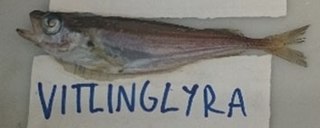
Trisopterus esmarkii, the Norway pout, is a species of fish in the cod family. It is found in the Barents Sea, North Sea, Baltic Sea, off the coasts of Norway, Iceland, the British Isles and elsewhere in the northeast Atlantic Ocean. It prefers depths between 100 and 200 m (330–660 ft), but occurs from 50 to 300 m (160–980 ft). Norway pout can reach 35 cm (14 in), but are more common at around 19 cm (7.5 in).

Trisopterus capelanus is a fish species belonging to the cod family (Gadidae). It is found in the Mediterranean Sea.

Gadella maraldi, the gadella or morid cod, is a species of fish in the family Moridae from the warmer waters of the north eastern Atlantic Ocean and the Mediterranean Sea.
Spinitectoides is a genus of parasitic nematodes, belonging to the family Cystidicolidae. Species of Spinitectoides are parasitic as adults in the gastrointestinal tract of fish. According to the World Register of Marine Species, the genus currently (2019) includes a single species, Spinitectoides berlandi.
